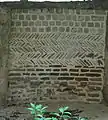| Château de Doué-la-Fontaine | |
|---|---|
 Surviving ruins of the aula, which later became the dungeon and then a standalone cellar | |
| General information | |
| Country | France |
| Construction started | c. 950 |
| Demolished | 1026 |
The Château de Doué-la-Fontaine, also known as Motte de la Chapelle, is a motte and bailey castle in Doué-la-Fontaine, France that was built upon the foundations of an older 9th century Carolingian aula, and the Château de Doué-la-Fontaine, having been built around the year 950, is widely believed to have been the oldest known castle built out of stone. Only the aula survives today,[1] while the castle and most of the motte no longer survive.[2]
History
On the site of the castle, an older Carolingian aula was built during the 9th century for the Count of Anjou[3] and was owned at one point by King Robert I of France before his death in 923. The Carolingian building, which measured 23 metres (75 ft) by 17 metres (56 ft), consisted of a large room of one level (an aula), with walls 1.80 meters thick,[4] was set on fire around 930-940, probably during a war between the counts of Anjou and the counts of Blois, and was demolished shortly after. Around 950, the stone castle was built by the Count of Blois (probably Robert, Count of Blois) and an annex cellar was also built using the remains of the older aula.[1] The castle was also elevated around 950 and in the 10th century, the aula, which was converted into a dungeon, was buried underneath a mound that was 5 metres (16 ft) tall and the Château was built atop it, and then the Château was eventually fortified during the latter half of the 10th century (1050-1099), but none of these fortifications survive today.
The keep was destroyed in 1026 by Fulk Nerra and the aula was made into a completely blind cellar along with the kitchen of the keep (which no longer survives today; only the Carolingian aula survives today,[1] which was built below the Medieval castle, and the motte upon which the castle was built[1]), and the kitchen being turned into a cellar during the 10th century is supported by the fact that graffiti was found dating to the 10th century written by an unknown man named Aimeri - all that is known about him is that he devoted this graffiti to King Louis the Pious.[5]
The site was refortified in both 1468 and 1472 (during the third quarter of the 15th century), but neither of these fortifications survive today either.[1] The motte was then known as "Motte de la Chapelle" and in 1966, the motte was going to be levelled by Michel de Boüard,[2] but when a mechanical device gutted the mound and uncovered traces of masonry, the site was stopped and the ruins were excavated and it was made a historical monument on December 19, 1973.[1] Most of the motte was still eventually flattened to expose as much of the ruins of the aula as possible.[2]
Gallery

_(24627165578).jpg.webp) Inside view of the ruined aula
Inside view of the ruined aula_(37784145054).jpg.webp) Ruins of a well(?)
Ruins of a well(?)_(38467119922).jpg.webp) Close-up view of the doorway
Close-up view of the doorway
References
- 1 2 3 4 5 6 Base Mérimée: Motte féodale et donjon (restes), Ministère français de la Culture. (in French).
- 1 2 3 Michel de Boüard, De l'aula au donjon. Les fouilles de la motte de La Chapelle, à Doué-la-Fontaine (Xe-XIe siècle). In:Archéologie médiévale, tome 3-4, 1973. pp. 5-110; doi : https://doi.org/10.3406/arcme.1973.1260)
- ↑ History of Doué-la-Fontaine and a collection of photos including a Carolingian residence and an ancient stone amphitheatre. (in English)
- ↑ André Châtelain (2003), Châteaux forts - Images de pierre des guerres médiévales, Paris, Rempart, (ISBN 2-904-365-001), p. 16.
- ↑ "The Carolingian aula of Doué-la-Fontaine". Histoire Pour Tous De France Et Du Monde. Retrieved 20 June 2021.